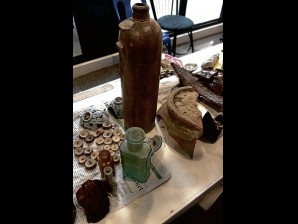Drainage canal yields priceless artifacts

MANY of the artifacts were broken by the jackhammer used by workers in digging a 60-meter-long canal for a drainage project along Arroyo Street, Iloilo City. GUIJO DUEÑAS
Workers digging a drainage canal in Iloilo City’s business district have found artifacts which historians believe may offer fresh insights into the locality’s rich heritage.
Among the treasures is a small porcelain bowl with a blue-and-white design, which may date back to the late Ming Dynasty (1368-1644), according to Armand Mijares, director of the Archaeological Studies Program (ASP) of the University of the Philippines (UP) in Diliman, Quezon City.
Some 30 pieces of coins, porcelain ware, bottles, jugs, wooden planks, pieces of iron ore and suspected animal bone fragments were also recovered in several layers at a depth of 1.2 meters.
Many of the artifacts were fragmented because the workers had used a jackhammer in digging a 60-meter-long canal along Arroyo Street.
James Mozart Amsua, curator of Museo Iloilo who also teaches anthropology at the University of San Agustin, described the find as significant because there had been no such major archaeological discovery in Iloilo in the past 30 years.
Article continues after this advertisementNeil Loyola, a researcher of the Cultural Properties Division of the National Museum, said the age of the artifacts could be determined through visual inspection.
Article continues after this advertisementThe discovery has spurred renewed interest in its history and Iloilo’s economic, political and cultural prominence before the Spanish colonizers arrived in 1521 up to the early 19th century. Amsua said the artifacts reflected settlements that existed even before the Spaniards came.
The area could have been an entrepot or a workshop for boat or ship repair based on fragments of iron ore found, Mijares said. It is near the Muelle Loney Street and around 150 m from the Iloilo River.

PORCELAIN bowls, bottles and other artifacts recovered by workers while digging in a drainage project in Iloilo City. GUIJO DUEÑAS
It is also along Iznart and J.M. Basa Streets, which are portions of an 800-m winding stretch known during the Spanish period as Calle Real (Royal Street).
The area is now part of the city proper described as a “swampy jungle” in a study titled “Historical Sites and Structures in Iloilo: A Focus on Industrial, Commercial and Related Institutions” and written by the late Western Visayas historian Henry Funtecha and Melanie Padilla of UP Visayas.
It was considered a fishing village of the then Jaro town, which was the commercial center of Iloilo province until the mid-19th century. Jaro rapidly developed and its population grew, especially along Calle Real after the port of Iloilo was formally opened to foreign trade in 1855.
It hosted large residential houses of Filipinos, Europeans, Chinese and Americans, Funtecha wrote in an article titled “Calle Real Through the Years,” which was published in the Iloilo Yearbook 2007.
Jaro became the seat of the government when the Spaniards moved the capitol from Arevalo town due to frequent attacks by Dutch and Moro pirates in the southern part of Iloilo, according to the study.
Iloilo rose to become a commercial center and most important port in the country next to Manila, mainly due to its strategic location, deep water channel and natural harbor protected from typhoons and strong winds.
In 1899, the Spaniards made Iloilo into a city, which earned the sobriquet “Queen City of the South” at the close of the 19th century.
Site inspection and further excavations are necessary to determine the age of the digging area and the condition when the artifacts were found, Mijares said.
Pieces and photographs of the find were brought to the ASP office, while the rest of the artifacts were kept at Museo Iloilo pending inspection by experts from the National Museum.
Mayor Jed Patrick Mabilog has ordered a stop to the digging activities. He directed the Iloilo City Cultural Heritage Conservation Council to supervise the verification of the artifacts through the National Museum.
“There could be more of these cultural treasures buried somewhere in the city,” Amsua surmised.